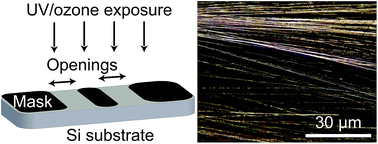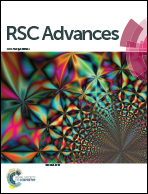Wettability gradient-induced alignment of peptide nanotubes as templates for biosensing applications†
Abstract
Self-assembled diphenylalanine (FF) peptide nanotubes (PNTs) have attracted significant attention due to their well-ordered supramolecular structure and wide range of functional capabilities that may enable potential nanobiotechnology applications. However, self-assembled PNTs are generally inhomogeneous at the macroscale, which has limited their potential use. Reproducibly controlling the assembly and alignment of PNTs is therefore critical to enable the widespread use of PNTs, e.g., in sensing applications. In this study, a surface patterning technique based on UV/ozone exposure through a mask is used to align PNTs. Exposed regions become hydrophilic, leading to directed spreading of the FF solution and alignment of the PNTs that improves as the difference in wettability between adjacent regions increases. Alignment was further found to depend on the concentration- and temperature-dependent diameter of the PNTs formed and the size of the hydrophilic area. Finally, aligned PNTs decorated with silver nanoparticles are used to sense an analyte molecule using surface enhanced Raman spectroscopy.


 Please wait while we load your content...
Please wait while we load your content...